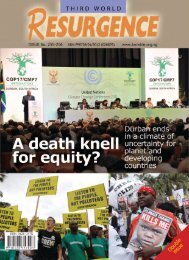Plantations, poverty and power - Critical Information Collective
Plantations, poverty and power - Critical Information Collective
Plantations, poverty and power - Critical Information Collective
You also want an ePaper? Increase the reach of your titles
YUMPU automatically turns print PDFs into web optimized ePapers that Google loves.
65<br />
“the exhaustive studies have clearly endorsed the benefits the mill will bring. We hope that today’s<br />
decision can contribute to convincing the various stakeholders that the mill will comply with relevant<br />
environmental st<strong>and</strong>ards <strong>and</strong> not compromise the wellbeing of the inhabitants in the area.” 320<br />
But research by World Rainforest Movement in the areas of Botnia’s industrial eucalyptus monocultures<br />
shows that IFC’s studies were far from “exhaustive”. Instead they played down the problems <strong>and</strong> most<br />
importantly, failed to take into account the views of local people living near the plantations.<br />
One of the IFC’s own reports illustrates problems. In April 2006, IFC hired Hatfield Consultants, a<br />
Canadian firm, to review Botnia’s (<strong>and</strong> Ence’s) environmental impact assessments. Hatfield’s report,<br />
written by Wayne Dwernychuk <strong>and</strong> Neil McCubbin, was critical of the assessments (which had already<br />
been accepted by the Uruguayan government). For example, Dwernychuk <strong>and</strong> McCubbin point out that in<br />
the previous assessments, “The reference to dioxins/furans in mill discharges appears to be h<strong>and</strong>led in a<br />
rather cavalier manner.” Dwernychuk <strong>and</strong> McCubbin noted that “These compounds are of significant<br />
concern to the general public, <strong>and</strong> should be discussed fully. Setting the issue aside by concluding that<br />
dioxins/furans will be at ‘undetectable levels’ is unacceptable.” 321<br />
Nevertheless, the IFC reported on its website that “Studies by independent university <strong>and</strong> international<br />
research centers have shown that wastewater from ECF bleaching is virtually free of toxic chlorinated<br />
compounds such as dioxin.” 322 IFC fails to explain what the phrase “virtually free” means in the context<br />
of dioxins, how this differs from “undetectable levels”, or even whether this poses a risk.<br />
Botnia is well aware of the risks of pollution from pulp mills. In 2003, a UPM pulp mill in Finl<strong>and</strong> spilled<br />
7,500 litres of black liquor into Lake Saimaa. A town called Bay of Hauki (named after a fish) is now<br />
known as “Pulp” because of the smell from the nearby pulp mill. 323<br />
Once the IFC loan was in place, other financiers jumped on board – without carrying out their own<br />
studies of the project. MIGA’s guarantee covers the investments for a period of up to 15 years, “against<br />
the risks of expropriation, war <strong>and</strong> civil disturbance, <strong>and</strong> breach of contract.” 324<br />
In April 2007, the Nordic Investment Bank (NIB) signed an agreement with the government of Uruguay<br />
to allow NIB to grant a loan to Botnia for its pulp mill. The agreement includes tax exemption to NIB <strong>and</strong><br />
its debtors in Uruguay. It also provides legal <strong>and</strong> administrative immunity for representatives of NIB. 325<br />
Finnvera is Finl<strong>and</strong>’s official export credit agency <strong>and</strong> is 100 per cent state-owned. In March 2007,<br />
320 “Botnia’s project approved by the boards of IFC <strong>and</strong> MIGA”, Botnia’s website:<br />
http://www.botnia.com/en/default.asppath=204;210;211;1097;1456<br />
321 Diana Cariboni “Uruguay: Environmental tweaks recommended for paper mills”, Inter Press Service, 13 April 2006.<br />
322 “FAQs: Uruguayan Pulp Mills”, IFC website: http://www.ifc.org/ifcext/lac.nsf/Content/Uruguay_PulpMills_FAQ<br />
323 Romina Picolitti, “Complaint on behalf of citizens affected by proposed paper mills in Fray Bentos, Uruguay”,<br />
CEDHA, no date. http://www.cedha.org.ar/docs/papermill-presentation.ppt<br />
Ricardo Carrere, “Tras la huella de la celulosa en Finl<strong>and</strong>ia. La otra cara de la moneda”, Grupo Guayubira, Junio de<br />
2005. http://www.guayubira.org.uy/celulosa/Finl<strong>and</strong>ia.html<br />
324 “Project: Botnia South America S.A.”, Multilateral Investment Guarantee Agency website.<br />
http://www.miga.org/sitelevel2/level2.cfmid=1078&proj=690&ghol=514<br />
325 “Repercussions of Agreement Signed Between Uruguay <strong>and</strong> Nordic Investment Bank”, Broadcast on<br />
radiomudoreal.fm, 20 April 2007. http://www.radiomundoreal.fm/rmr/q=en/node/22316















